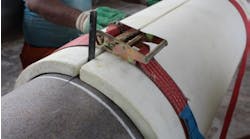OTC 2014: Emerson completes first deployment of downhole wireless sensor system on Statoil’s Skuld field
Offshore staff
HOUSTON – Emerson Process Management today announced the successful first deployment of its Roxar Downhole Wireless PT Sensor System. The new instrument has been deployed as part of the completion on Statoil’s Skuld field in the Norwegian North Sea, where it is measuring online and in real-time pressure and temperature information from behind the casing in the subsea production well. The result for Statoil will be a tool for well integrity monitoring and offshore safety as well as adherence to Norwegian legal requirements to monitor pressure in the B annulus behind the well casing.
“Statoil took the initiative toward Emerson to develop technology for B-annulus monitoring on subsea wells,” said Hilde Brandanger Haga, who leads engineering–well integrity for Statoil ASA. “Statoil is pleased with the successful installation and expects to have the Emerson technology qualified to TRL7, Proven Technology by early April 2014.”
The announcement also comes at a time when Emerson is expanding its Roxar downhole monitoring business into the UK sector, with its Aberdeen-based team responsible for a number of pending installations of the system on the UK continental shelf. The Roxar Downhole Wireless PT Sensor System provides a means of detecting any variations in pressure and temperature behind the casing in subsea wells and, in particular in the B annulus.
Through the providing of an early warning of abnormal pressure variations, operators will be able to ensure that remedial action is scheduled and implemented in a timely manner, thereby protecting well integrity and ensuring offshore safety. The deterioration of cement seals or loss of casing integrity due to increased pressure behind the well casing can allow injection or reservoir gas to migrate vertically along the outside of the casing, leading to a number of unwanted and potentially hazardous conditions, such as uncontrolled gas escaping at the surface or, in the worst-case scenario, a shallow gas blow out due to failed barriers in the casing.
With the Roxar Downhole Wireless PT Sensor System, however, operators will be able to monitor Annulus B pressure and temperature wirelessly and continuously online for the life of the well, thereby providing positive confirmation of the pressure barrier’s integrity. The tool will also negate the sometimes excessive and expensive over dimensioning of casings that can take place to compensate for worst-case scenarios and will also potentially provide operators with significant cost savings previously incurred in shutting in wells, due to their lack of ability to verify barrier integrity.
The Roxar Downhole Wireless PT Sensor System consists of anIntegrated Downhole Network (IDN) system to carry signals from the wellbore to the customer's monitoring system, a Downhole Network Controller Card (DHNC) placed in the subsea structure, and a wireless reader and PT transponder, and is part of Emerson's fully integrated downhole monitoring system provided on the Skuld field.
The new instrument is attached to the same cable as other Emerson reservoir monitoring gauges (up to 32 can be deployed on the same cable) and is one element of Emerson’s integrated Roxar Permanent Downhole Monitoring Systems (PDMSs). The installation took place in two phases, with the PT transponder installed as part of the casing in September 2013, followed by the wireless reader being installed as part of the completion in February 2014. The entire system has been rigorously tested and is rated to operate at temperatures up to 225°C. The installation for Statoil has a minimum expected lifetime of 20 years.
The Skuld offshore field is located within the Halten Bank area, north of the Norne field in blocks 6609/10 and 6608/11 in the Norwegian Sea. The field is situated in water depths of 360 m (1,181 ft) and involves three production wells and three water injectors. The Roxar Downhole Wireless PT Sensor System has been installed on Well S-4. Statoil is the owner and operator of Skuld, with a 64% interest, whilePetoro and Eni are its partners.
05/05/2014


